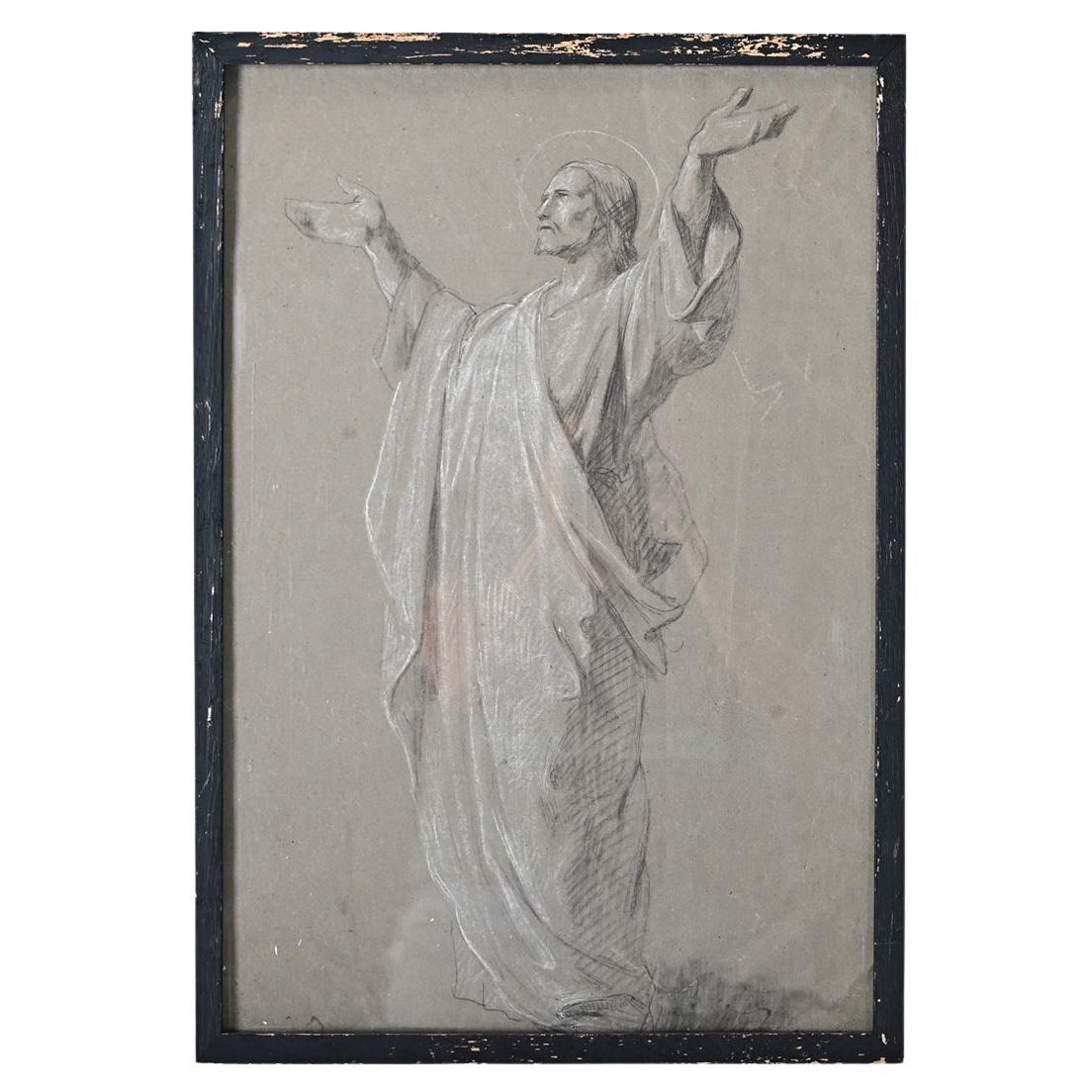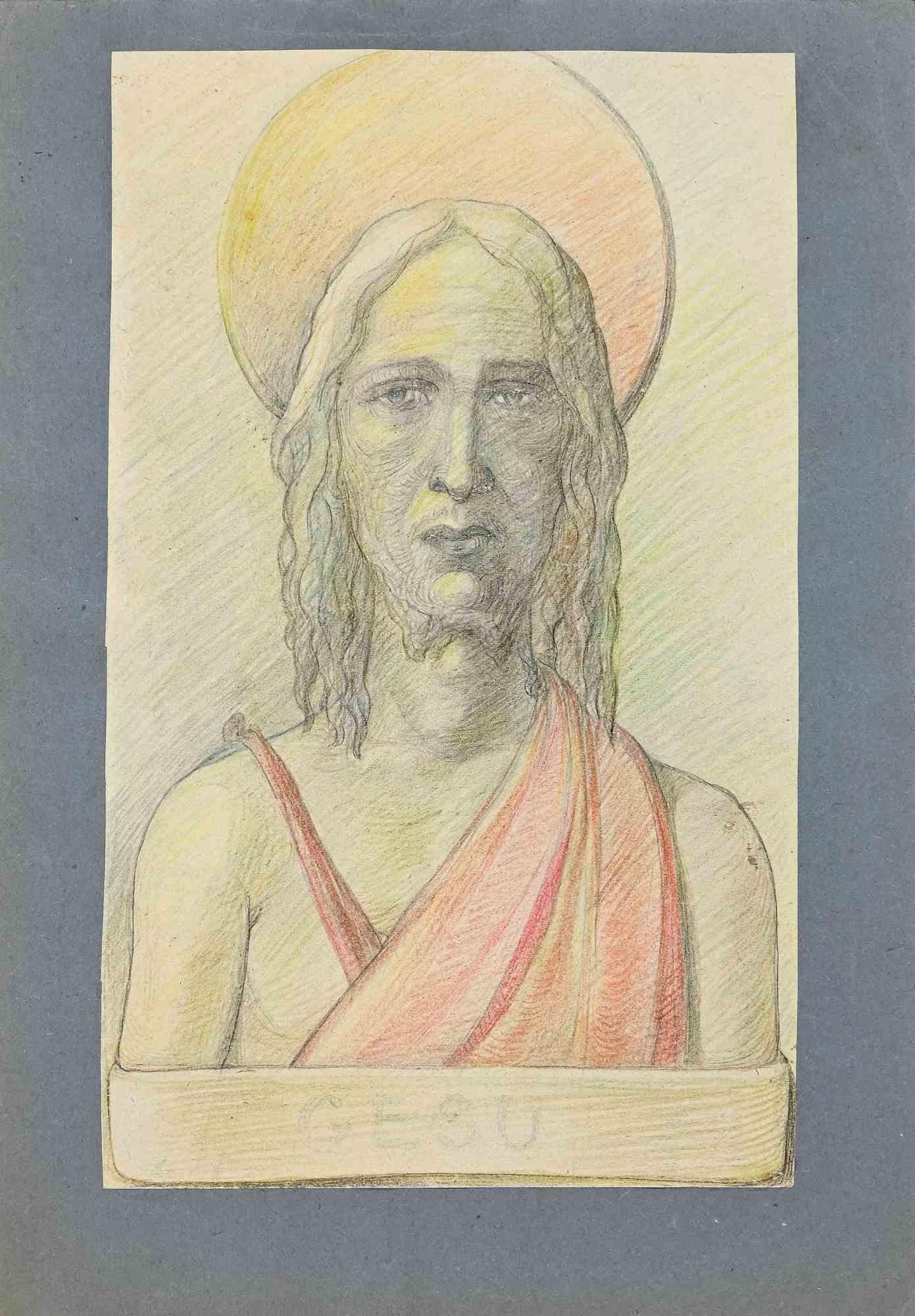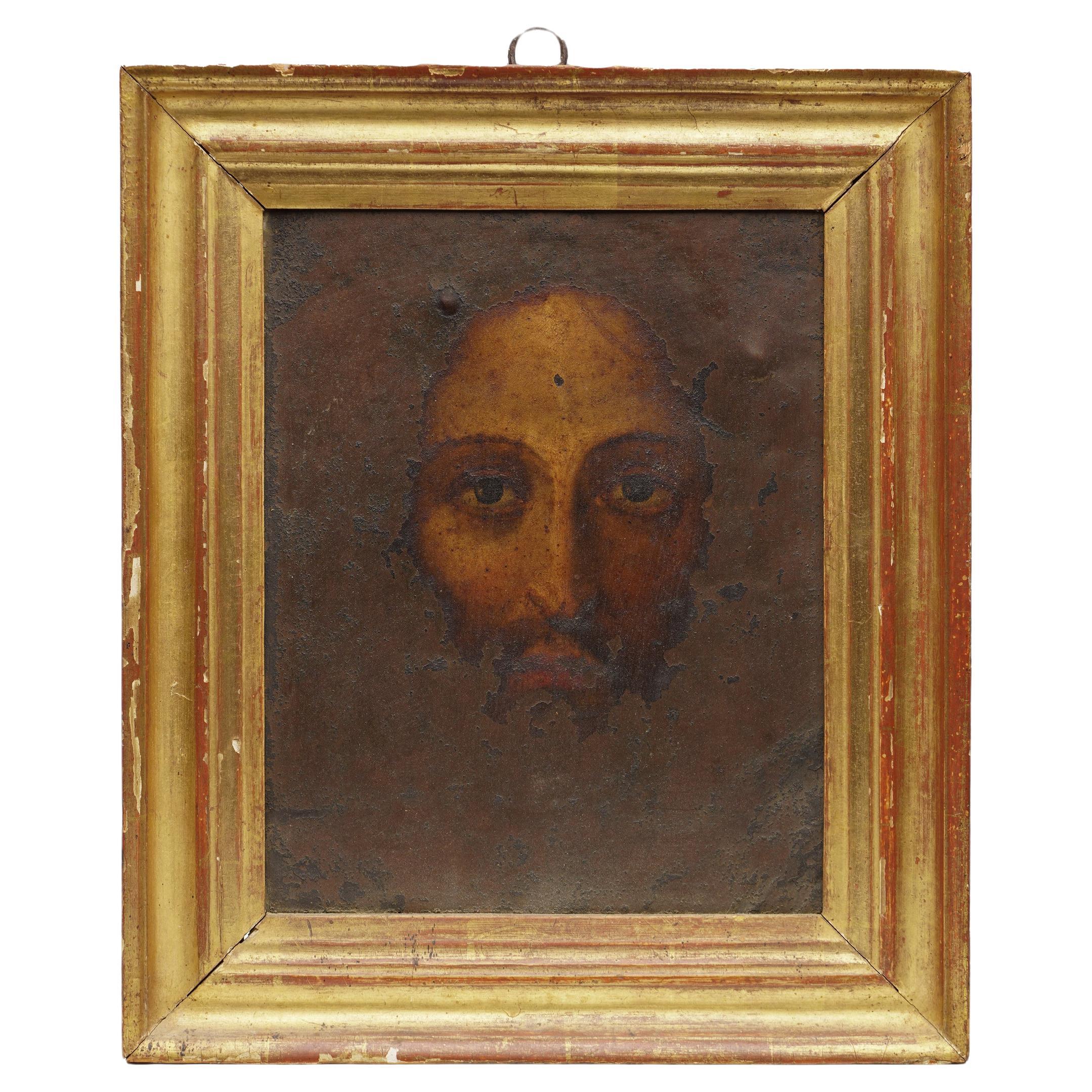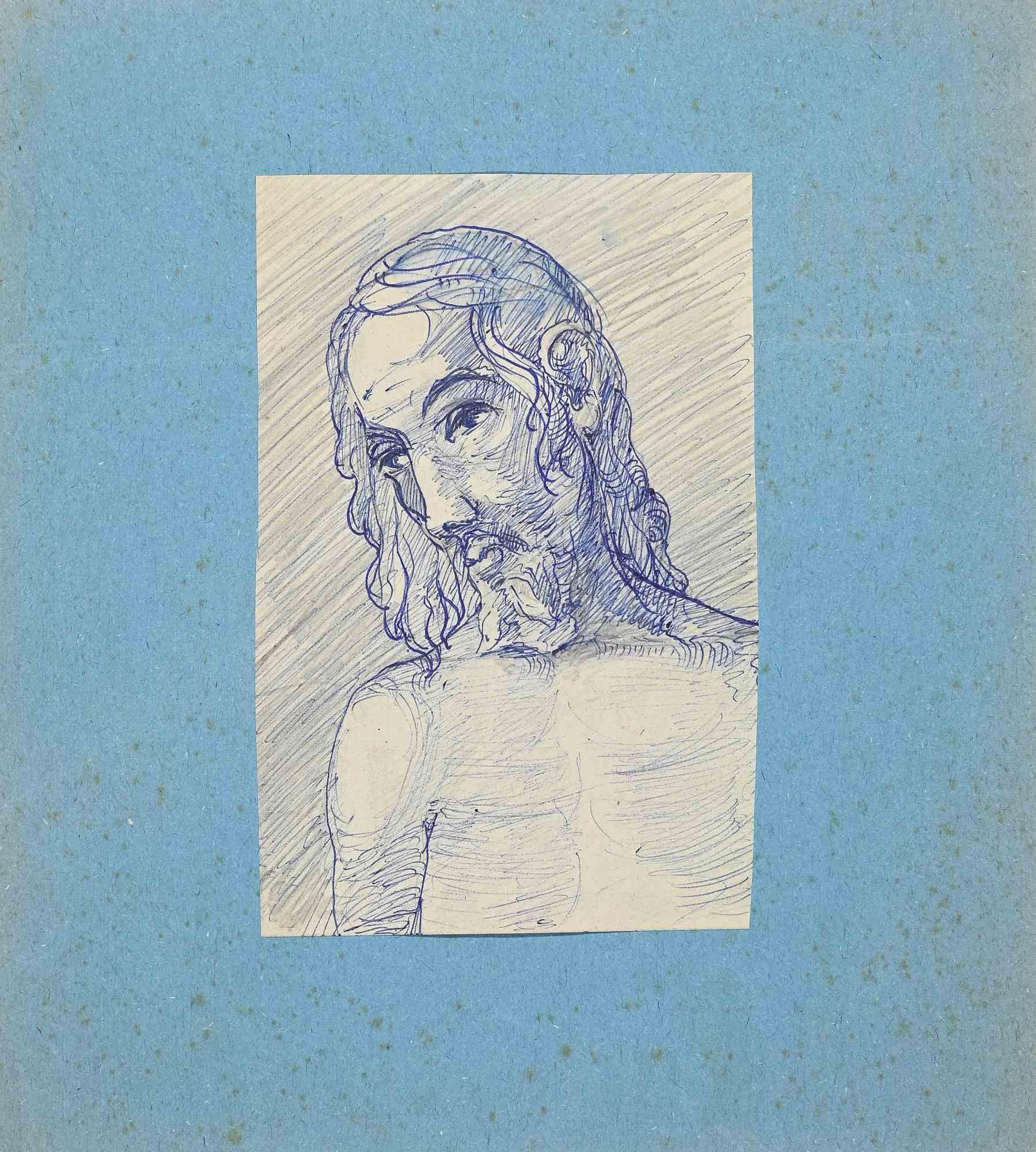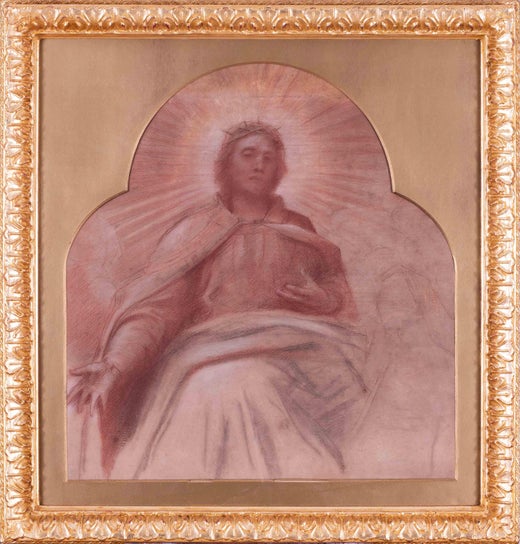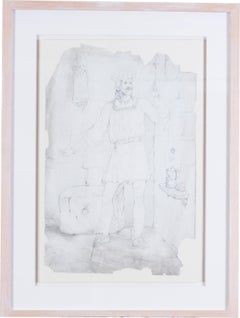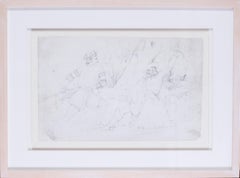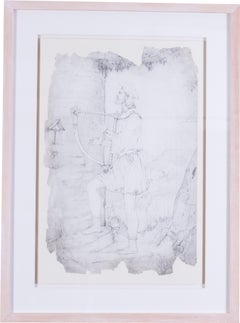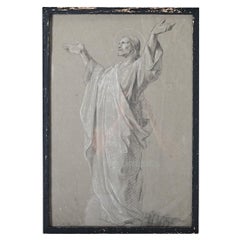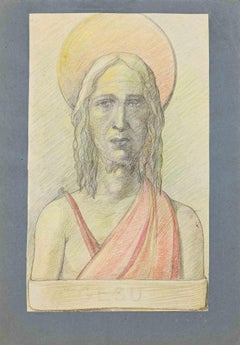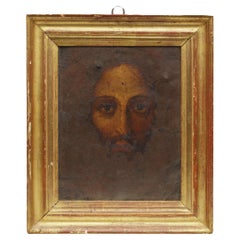Items Similar to British 19th Century chalk drawing of Christ in Glory by G F Watts
Want more images or videos?
Request additional images or videos from the seller
1 of 11
George Frederic WattsBritish 19th Century chalk drawing of Christ in Glory by G F Watts
$6,584.49
£4,800
€5,623.25
CA$9,248.24
A$10,181.62
CHF 5,203.85
MX$121,520.44
NOK 66,256.13
SEK 62,000.96
DKK 42,002.41
About the Item
George Frederic Watts (British, 1817-1904)
Christ in Glory
Red chalk in an arched mount
Inscribed verso, including a signed letter verso from R H Jefferies, Curator of The Watts Gallery
Not signed by the artist
19.25" x 18" (48.8 x 45.5cm)
Exhibited: The Watts Gallery, 1995.
Notes: This important drawing dates to the late 1850's and was the concept for
the centre piece of a fresco commissioned for the chancel of St James the Less, Westminster
George Frederic Watts, who was interested in the Elgin Marbles from an early age, first worked in the studio of the sculptor William Behnes and then turned to portraits and later to history painting. He first exhibited at the Royal Academy in 1837 and travelled in Italy during the mid-1840s. In 1850 he moved into Little Holland House as the semi-permanent guest of Thoby Prinsep and his wife, Sara. He decorated the dining room there, and also a town house in London, and completed a mural for the Great Hall at Lincoln's Inn. Watts was elected a full member of the Royal Academy in 1867 and began to enjoy increasing success; in 1881–82 there was a retrospective of his work at the Grosvenor Gallery, London, the first such exhibition devoted to the oeuvre of a living artist.
- Creator:George Frederic Watts (1817 - 1904, British)
- Dimensions:Height: 10.25 in (26.04 cm)Width: 18 in (45.72 cm)Depth: 1 in (2.54 cm)
- Medium:
- Movement & Style:
- Period:
- Condition:Paper oxidised, original crease runs through the horizontal (upper edge), a few scuffs. The new owner could decide to get the drawing lightened by a restorer if required. In a gilt mount, some of the gilt coming away at the slip edge.
- Gallery Location:Petworth, GB
- Reference Number:1stDibs: LU540312179162
George Frederic Watts
George Frederic Watts OM, RA (1817 – 1904) was considered one of the greatest artists of the Victorian era, internationally renowned and celebrated in his own lifetime. He pursued an individual artistic approach and is remembered most for his large-scale symbolist paintings reflecting Victorian sensibilities and Hall of Fame portraits, capturing his distinguished contemporaries in Victorian society. In artistic terms he is significant not only because of the works he produced, but because of his determined innovation in developing an artistic practice which was not tied to a larger artistic movement. A portraitist, sculptor, landscape painter and symbolist, Watts's work embodied the most pressing themes and ideas of the time, earning him the title England's Michelangelo.
About the Seller
4.9
Platinum Seller
Premium sellers with a 4.7+ rating and 24-hour response times
Established in 2010
1stDibs seller since 2017
273 sales on 1stDibs
Typical response time: 2 hours
- ShippingRetrieving quote...Shipping from: Petworth, United Kingdom
- Return Policy
Authenticity Guarantee
In the unlikely event there’s an issue with an item’s authenticity, contact us within 1 year for a full refund. DetailsMoney-Back Guarantee
If your item is not as described, is damaged in transit, or does not arrive, contact us within 7 days for a full refund. Details24-Hour Cancellation
You have a 24-hour grace period in which to reconsider your purchase, with no questions asked.Vetted Professional Sellers
Our world-class sellers must adhere to strict standards for service and quality, maintaining the integrity of our listings.Price-Match Guarantee
If you find that a seller listed the same item for a lower price elsewhere, we’ll match it.Trusted Global Delivery
Our best-in-class carrier network provides specialized shipping options worldwide, including custom delivery.More From This Seller
View AllPre-Raphaelite, early 19th Century drawing by the British artist Lord Leighton
By Frederic Leighton
Located in Petworth, West Sussex
Lord Frederick Leighton (British, 1830-1896)
A Medieval Allegory
Not signed
pencil on paper
the fragment measures approx. 19.1/2 x 13 in.
(49.5 x 33 cm.)
Provenance: Gifted by Leighton to his cousin Edith Emily Jellicorse, nee Garnham, and thence by descent.
We would like to thank Daniel Robins, the curator at Leighton House for the authenticating this work in full.
Daniel has suggested this study would have been executed when Leighton was studying in Frankfurt
Leighton was born in Scarborough to Augusta Susan and Dr. Frederic Septimus Leighton. He received his artistic training on the European continent, first from Eduard von Steinle and then from Giovanni Costa. According to Daniel Robbins, the curator at Leighton House, This drawing comes from the time Leighton studied under Eduard von Steinle. He then studied at the Accademia di Belle Arti in Florence. From 1855 to 1859 he lived in Paris, where he met Ingres, Delacroix, Corot and Millet. In 1860, he moved to London, where he associated with the Pre-Raphaelites. In 1864 he became an associate of the Royal Academy and in 1878 he became its President (1878–96). American art critic Earl Shinn claimed at the time that "Except Leighton, there is scarce any one capable of putting up a correct frescoed figure in the archway of the Kensington Museum." His paintings represented Britain at the great 1900 Paris Exhibition. Leighton was knighted at Windsor in 1878 and was created a baronet, of Holland Park Road eight years later. He was the first painter to be given a peerage. Leighton remained a bachelor and rumours of him having an illegitimate child with one of his models, in addition to the supposition that Leighton may have been a homosexual, continue to be debated. On his death his barony was extinguished after existing for only a day; this is a record in the Peerage. His house in Holland Park, London has been turned into a museum. It contains many of his drawings and paintings, as well as some of his former art collection including a painting dedicated to Leighton by Sir John Everett Millais. The house also features many of Leighton's inspirations, including his collection of Iznik tiles. Its centrepiece is the magnificent Arab Hall. Leighton was an enthusiastic volunteer soldier, enrolling with the first group to join the 38th Middlesex (Artists') Rifle Volunteer Corps (later to be known as the Artists Rifles...
Category
19th Century Pre-Raphaelite Figurative Drawings and Watercolors
Materials
Paper, Pencil
Lord Frederick Leighton drawing, British pre-Raphaelite, original
By Frederic Leighton
Located in Petworth, West Sussex
Lord Frederick Leighton (British, 1830-1896)
Apprehending a thief
pencil on paper
the fragment measures approx. 17.1/3 x 11in. (44 x 28cm.)
signed ‘F Leighton’ (lower right)
Provenance: Gifted by Leighton to his cousin Edith Emily Jellicorse, nee Garnham, and thence by descent
We would like to thank Daniel Robins, the curator at Leighton House for the authenticating this work in full.
Daniel has suggested this study would have been executed when Leighton was studying in Frankfurt
Leighton was born in Scarborough to Augusta Susan and Dr. Frederic Septimus Leighton. He received his artistic training on the European continent, first from Eduard von Steinle and then from Giovanni Costa. According to Daniel Robbins, the curator at Leighton House, This drawing comes from the time Leighton studied under Eduard von Steinle. He then studied at the Accademia di Belle Arti in Florence. From 1855 to 1859 he lived in Paris, where he met Ingres, Delacroix, Corot and Millet. In 1860, he moved to London, where he associated with the Pre-Raphaelites. In 1864 he became an associate of the Royal Academy and in 1878 he became its President (1878–96). American art critic Earl Shinn claimed at the time that "Except Leighton, there is scarce any one capable of putting up a correct frescoed figure in the archway of the Kensington Museum." His paintings represented Britain at the great 1900 Paris Exhibition. Leighton was knighted at Windsor in 1878 and was created a baronet, of Holland Park Road eight years later. He was the first painter to be given a peerage. Leighton remained a bachelor and rumours of him having an illegitimate child with one of his models, in addition to the supposition that Leighton may have been a homosexual, continue to be debated. On his death his barony was extinguished after existing for only a day; this is a record in the Peerage. His house in Holland Park, London has been turned into a museum. It contains many of his drawings and paintings, as well as some of his former art collection including a painting dedicated to Leighton by Sir John Everett Millais. The house also features many of Leighton's inspirations, including his collection of Iznik tiles. Its centrepiece is the magnificent Arab Hall. Leighton was an enthusiastic volunteer soldier, enrolling with the first group to join the 38th Middlesex (Artists') Rifle Volunteer Corps (later to be known as the Artists Rifles...
Category
19th Century Pre-Raphaelite Figurative Drawings and Watercolors
Materials
Paper, Pencil
An early 19th Century drawing by the British pre-Raphaelite artist Lord Leighton
By Frederic Leighton
Located in Petworth, West Sussex
Lord Frederick Leighton (British, 1830-1896)
A very early study of a Medieval Minstrel
pencil on paper
Not signed
the fragment measures approx. 19.1/2 x 13 in.
(49.5 x 33 cm.)
Provenance: Gifted by Leighton to his cousin Edith Emily Jellicorse, nee Garnham, and thence by descent.
We would like to thank Daniel Robins, the curator at Leighton House for the authenticating this work in full.
Daniel has suggested this study would have been executed when Leighton was studying in Frankfurt
Leighton was born in Scarborough to Augusta Susan and Dr. Frederic Septimus Leighton. He received his artistic training on the European continent, first from Eduard von Steinle and then from Giovanni Costa. According to Daniel Robbins, the curator at Leighton House, This drawing comes from the time Leighton studied under Eduard von Steinle. He then studied at the Accademia di Belle Arti in Florence. From 1855 to 1859 he lived in Paris, where he met Ingres, Delacroix, Corot and Millet.
In 1860, he moved to London, where he associated with the Pre-Raphaelites. In 1864 he became an associate of the Royal Academy and in 1878 he became its President (1878–96). American art critic Earl Shinn claimed at the time that "Except Leighton, there is scarce any one capable of putting up a correct frescoed figure in the archway of the Kensington Museum." His paintings represented Britain at the great 1900 Paris Exhibition.
Leighton was knighted at Windsor in 1878 and was created a baronet, of Holland Park Road eight years later. He was the first painter to be given a peerage.
Leighton remained a bachelor and rumours of him having an illegitimate child with one of his models, in addition to the supposition that Leighton may have been a homosexual, continue to be debated. On his death his barony was extinguished after existing for only a day; this is a record in the Peerage. His house in Holland Park, London has been turned into a museum. It contains many of his drawings and paintings, as well as some of his former art collection including a painting dedicated to Leighton by Sir John Everett Millais. The house also features many of Leighton's inspirations, including his collection of Iznik tiles. Its centrepiece is the magnificent Arab Hall.
Leighton was an enthusiastic volunteer soldier, enrolling with the first group to join the 38th Middlesex (Artists') Rifle Volunteer Corps (later to be known as the Artists Rifles...
Category
19th Century Pre-Raphaelite Figurative Drawings and Watercolors
Materials
Paper, Pencil
British, turn of the century watercolour of an angel by Lexden Lewis Pocock
Located in Petworth, West Sussex
Lexden Lewis Pocock (British, 1850 – 1919)
An angel
Watercolour on paper
Signed ‘Lexden. L. Pockock’ (lower right)
15.1/4 x 6.1/2 in. (38.8 x 16.3 cm.)
Lexden Lewis Pocock (1850–191...
Category
20th Century Pre-Raphaelite Figurative Drawings and Watercolors
Materials
Paper, Watercolor
Art Deco British symbolist painting 'Triune' by Robert Arthur Wilson
By Robert Arthur Wilson
Located in Petworth, West Sussex
This artwork is a captivating representation of The Trinity, created by the British artist Robert Arthur Wilson. It vividly demonstrates Wilson's profound engagement with avant-garde theories related to colour, music, and emotion, which had a significant impact on his artistic vision. Wilson's exploration of colour abstraction was groundbreaking and played a pivotal role in establishing him as one of the most promising artists of his time. His innovative approach to colour abstraction is evident not only in the portrayal of the sky but also in the overall composition of this piece.
Robert Arthur Wilson (British, 1884 – 1979)
Triune
Tempera on panel
Signed ‘R.A. Wilson’ (lower right) and titled on a label on the reverse
29.1/8 x 29.1/8 in. (69 x 69 in. )
Robert Arthur Wilson was a British painter. Wilson was born in Sunderland in 1884. Leaving school at the age of thirteen, he was employed for a time as a bookkeeper before beginning an apprenticeship under a local sign...
Category
20th Century Symbolist Figurative Paintings
Materials
Tempera, Panel
British 19th Century drawing of a nude by Edward Stott
By Edward Stott
Located in Petworth, West Sussex
Edward Stott, ARA (British, 1859 - 1918)
Reclining nude
Pastel and black crayon
8.1/2 x 12.1/4 in. (21.7 x 31.2 cm.)
Provenance: Abbott and Holder, London
A few years after its foundation in 1886, a critic referred to the New English Art Club as that Steery, Starry, Stotty. Stotty referred to William Stott of Oldham and Edward William Stott. The four men had in common the love French plein air painting...
Category
19th Century Academic Nude Drawings and Watercolors
Materials
Crayon, Pastel
You May Also Like
French Vintage Charcoal Drawing of Jesus
Located in Baton Rouge, LA
French, early 20th century (if not prior) charcoal and chalk drawing of a risen Jesus Christ. Beautiful in its monochromatic palette, the work highlights the gathering of fabric in h...
Category
20th Century French French Provincial Drawings
Materials
Glass, Wood, Paper
Old Masters Chalk Drawing, 17th Century Italian Sanguine on Paper
Located in London, GB
Sanguine chalk on paper
Image size: 7 x 8 1/2 inches (18 x 22 cm)
Acid free cut-out mount
This 17th century drawing depicts a reclining woman with her back.
The Sanguine chalk that...
Category
17th Century Italian School Figurative Drawings and Watercolors
Materials
Paper, Chalk
Portrait of Christ - Original Drawing - Early 20th Century
Located in Roma, IT
Portrait of Christ is an original artwork realized by the Unknown Artist in the early 20th century.
Original colored pencil drawing on ivory-colored paper, glued on colored cardboa...
Category
Early 20th Century Modern Figurative Drawings and Watercolors
Materials
Pen, Pastel
$250 Sale Price
40% Off
Early 19th Century Oil Painting of Jesus on Copper Panel
Located in Braintree, GB
Early 19th Century Oil Painting of Jesus on Copper Panel.
Presented is an early 19th-century artwork, meticulously rendered with oil on a copp...
Category
Antique Early 1800s Italian Neoclassical Paintings
Materials
Copper
Portrait of Christ - Original Drawing - Early 20th Century
Located in Roma, IT
Portrait of Christ is an original artwork realized by the Unknown Artist in the early 20th century.
Original pen drawing on ivory-colored paper...
Category
Early 20th Century Modern Figurative Drawings and Watercolors
Materials
Pen
$250 Sale Price
40% Off
Antique Spanish Old Master Oil on Wood Panel, Head Portrait of Christ
Located in Cirencester, Gloucestershire
Artist/ School: 18/19th Century Spanish School
Title :Head study of Christ
Medium: oil painting on wood panel, period gilt framed
panel : 6 x 5 inches
Provenance: private collect...
Category
18th Century Old Masters Figurative Paintings
Materials
Oil
More Ways To Browse
Holland House
By Watts Art
George Frederic Watts
Watercolour 1912
1940s Charcoal
Arpege Lanvin Vintage
French Uniform
Vogue Illustration
Italian Charcoal Drawing
17th Ink Drawings
Dome Of The Rock
German Expressionists Drawings
India Watercolour 19th Century
Muybridge Horse
Pencil Drawing Church
The Scarecrow
Bust Drawing
Drawing In Sanguine
